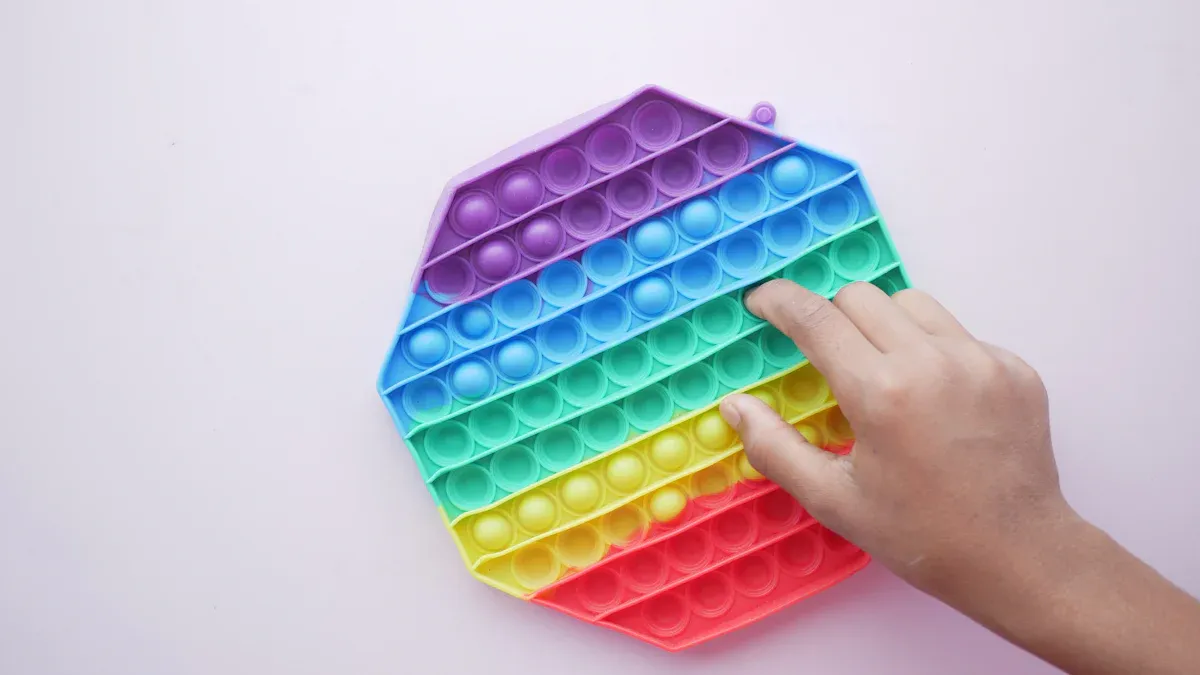How to Identify and Meet Sensory Needs with Autism

Have you ever felt stressed by loud sounds or bright lights? Many people with autism feel these things even more strongly. Studies indicate that nearly 90% of autistic individuals perceive sounds, sights, and touch in unique ways. If you understand these sensory needs, you can help make life easier and happier for everyone. When you show care and accept how each person sees the world, you help build better and more trusting friendships.
Key Takeaways
Understanding sensory processing is crucial. Learn how the tactile, vestibular, and proprioceptive systems help people with autism.
Watch for signs of sensory needs. Actions like covering ears or moving a lot can show how someone feels about their surroundings.
Make places more sensory-friendly. Change the lights, lower the noise, and give calm spaces. This helps people feel safe and pay attention.
Use sensory tools and activities. Things like fidget toys, weighted blankets, and sensory tables can help with sensory needs. These items also make people feel better.
Help people speak up for themselves. Teach them to share their sensory needs. This builds confidence and helps them get support.
Sensory Processing in Autism

What Is Sensory Processing?
You use your senses to learn about the world. Sensory processing is how your brain takes in this information. It helps you know how to react. In occupational therapy, experts talk about three main parts of sensory processing:
Tactile System: This system helps you feel touch, pain, temperature, and pressure. If it works differently, you might feel too much or too little from touching things.
Vestibular System: This part is inside your inner ear. It helps you know when you move or tilt your head. If it works differently, you might feel dizzy or want to spin and jump a lot.
Proprioceptive System: This system uses your muscles and joints. It tells you where your body is. If it does not work well, you might bump into things or have trouble balancing.
Why Sensory Processing Differs
People with autism often have different sensory processing. Some people feel things very strongly. Others barely notice them. Over 90% of autistic children have these differences. These needs can show up in many ways. Some people cover their ears in loud places. Others like hugs and squeezes. Sensory processing differences can change how you connect with others. They can also affect how independent you feel.
Neurodiversity means everyone’s brain works in its own way. When you accept these differences, you help make a safe and understanding world for autistic people.
Impact of Unmet Sensory Needs
If sensory needs are not met, daily life can get hard. Sensory overload can make you feel upset or cause meltdowns. Some kids might rock, flap their hands, or act out. Others might seem far away or not answer when you call them. Here is a quick look at how sensory processing affects people with autism spectrum disorder:
Evidence | Description |
|---|---|
Sensory Processing Issues | Many autistic children have hypo- or hyper-sensitivity. This can make daily life and friendships harder. |
Emotional Regulation Difficulties | Trouble with sensory integration can make it hard to control feelings and behavior. |
Behavioral Manifestations | Actions like rocking or hand-flapping help with too much or too little sensory input. |
When you see these signs, you can start to help meet sensory needs. This can help everyone feel better.
Recognizing Sensory Needs
Knowing how to spot sensory needs in autism can help you support your child or student every day. You might see behaviors or reactions that seem different. These signs show that someone experiences the world in their own way.
Common Signs
There are many signs when a person has sensory needs. Some children want certain sensations, while others try to avoid them. These actions can change how they focus, learn, and talk with others. Here is a table with some of the most common signs:
Sensory Need Type | Description |
|---|---|
Sensory Seeking | Children may jump, spin, or touch everything. They look for strong sensations to feel comfortable. |
Heterogeneous Profiles | Every child with autism has a unique mix of sensory needs and responses. |
You might see a child cover their ears, stay away from bright lights, or want to touch different things. Some children flap their hands or rock back and forth. Others might not react to loud noises or notice when they get hurt. These actions are not just habits. They help manage sensory issues and help the child feel safe.
Types of Sensitivities
Sensory needs in autism can look very different for each person. Some children react strongly to sounds, lights, or touch. Others may not notice these things at all. Experts call these reactions hyper-reactivity and hypo-reactivity.
Hyper-reactivity means a child feels things too much. Everyday sounds, smells, or textures can feel like too much. This can cause anxiety, discomfort, or even sensory overload. You might see a child cover their ears, avoid some clothes, or get upset in bright places.
Hypo-reactivity is the opposite. A child may not notice pain, hunger, or loud noises. They might look for strong sensations by making loud sounds, spinning, or touching everything. Sometimes, they do not answer to their name or seem unaware of what is happening.
Here is a table that shows some common types of sensitivities and how they look:
Type of Sensory Sensitivity | Manifestations |
|---|---|
Hypersensitivity | Covering ears, avoiding certain clothes, distress from lights, strong reactions to smells or tastes, discomfort with touch or crowds |
Hyposensitivity | Constant movement, not noticing hunger or pain, attraction to loud noises or bright lights, sensory seeking behaviors like rocking |
You may see both types in the same child. Sensory needs can change from day to day or even hour to hour.
Observation Tips
You can learn a lot by watching how a child reacts to things around them. Here are some expert tips to help you spot sensory needs in autism:
Create a Sensory-Friendly Space: Make a calm area with soft lights and cozy textures. This helps you see if your child feels better in certain places.
Build a Daily Sensory Routine: Add regular activities like swinging or jumping jacks. Watch if these help your child stay calm or focused.
Offer Heavy Work Activities: Let your child do things like wall push-ups or carry groceries. These give deep pressure input and can help with regulation.
Engage in Tactile Play: Start with dry textures like rice or beans. Slowly try messier play, but always respect your child’s comfort.
Use Visual Supports: Visual schedules and timers can lower anxiety and help your child know what will happen next.
Respect Their Sensory Profile: Watch closely and take notes on what helps or upsets your child. Every child with autism spectrum disorder has a unique sensory profile.
Tip: Every child is different. What works for one may not work for another. Try different ideas and see what helps your child feel safe and happy.
Sometimes, it is hard to spot sensory issues. You might not always know what causes a reaction. Talking to other families, joining support groups, or asking professionals can give you new ideas. Occupational therapy, sensory-friendly spaces, and techniques like deep breathing or using sensory toolkits can help a lot.
Culture also shapes how families see and support sensory needs. Being open to different values and ways helps you build trust and find the best support for your child. Here is a quick look at why cultural sensitivity matters:
Benefit of Cultural Sensitivity | Description |
|---|---|
Improved Communication | Helps families and professionals understand each other better. |
Better Support Systems | Makes it easier to create plans that fit your family’s values. |
Increased Trust | Builds strong relationships based on respect and understanding. |
It takes time and patience to recognize sensory needs. You may need to try different things before you find what works best. Remember, your support helps your child feel understood and valued.
Meeting Sensory Needs

To help someone with autism feel good, you need to understand their sensory world. You can help by changing the space, using helpful tools, and teaching self-advocacy. Let’s see how you can do this every day.
Sensory-Friendly Environments
You can make a space feel safe for someone with autism. Many people with autism get overwhelmed by bright lights, loud sounds, or strong smells. These things can cause sensory overload. It can be hard to focus or relax when this happens. Try these ideas to make your home, classroom, or public place more sensory-friendly:
Switch harsh lights to soft ones. Use lamps or let in sunlight. Sunglasses or hats can help with bright lights.
Use noise-canceling headphones to block loud noises. Quiet spaces, like a reading corner or small room, give a break from busy places.
Pick soft, comfy clothes. Let your child choose what feels good. Offer things like stress balls or soft cushions for comfort.
Keep some areas free of strong smells. Use unscented cleaners and skip air fresheners.
Make a quiet spot for breaks. This could be a tent, beanbag chair, or small nook.
Tip: When you lower sensory triggers, you help reduce anxiety. This makes it easier for someone with autism to join in. A calm space also helps with learning and being independent.
Schools and public places can help too. Many now have sensory rooms with dim lights and soundproofing. These rooms give a break from busy halls and help with feelings. Clear signs and visual routines help people know what will happen next. When you design spaces for sensory needs, you help everyone feel welcome.
Sensory Tools and Activities
You can use many tools and activities to help with sensory needs. These help with focus, calm, and self-control. Here are some helpful options:
Sensory Tool | Benefits |
|---|---|
Sensory Tables | Help with focus, lower anxiety, and improve sensory processing |
Increase on-task behavior, reduce anxiety, and give a sense of security | |
Weighted Blankets | Calm the body, improve sleep, and offer comfort |
Fidget Toys | Support self-regulation and coping skills |
Lower sensory overload and help with emotional regulation |
You might see your child relax with a weighted blanket or focus better with a fidget toy. Sensory tables with rice, beans, or water help with touch and attention. Many families use weighted vests, which can help kids stay on task. These tools are easy to use at home or school.
Some children do well with a sensory diet. This is a plan with regular activities like jumping, swinging, or squeezing putty. Research on sensory diets is mixed, but many families say these routines help. You can work with an occupational therapist to find the right mix. Regular sensory activities can lower anxiety, help with focus, and teach self-control.
Here are some ideas you can try:
Offer heavy work, like carrying groceries or pushing a laundry basket.
Use visual schedules to show what will happen next.
Try calming activities, like deep breathing, soft music, or gentle rocking.
Let your child pick sensory tools that feel good to them.
Note: Routines help manage sensory input. When your child knows what to expect, they feel safer and less worried. Visual schedules and daily patterns build confidence and independence.
You can also use tools like noise-canceling headphones, stim toys, and sensory apps. These help manage sensory issues and give comfort during tough times. Sensory therapists often use these tools to help kids with autism regulate their senses.
Self-Advocacy
Teaching self-advocacy is a great way to help someone with autism. When you help your child understand their sensory needs, you give them power to speak up. This builds confidence and helps them get support.
You can start by helping your child:
Find their strengths and interests.
Make a sensory profile or map to show what feels good or bad.
Learn how they process information best—do they like pictures, sounds, or hands-on activities?
Build a vocabulary for feelings and body states. Words like “overwhelmed,” “calm,” or “itchy” help them explain what they need.
Know their rights at school and in the community.
Self-advocacy means your child can ask for breaks, pick tools that help, or say when something feels wrong. This skill grows over time. You can show self-advocacy by talking about your own needs and showing how to ask for help.
Remember: When you support self-advocacy, you help your child feel respected and understood. They learn to trust themselves and others, which leads to better well-being and independence.
Meeting sensory needs is not just about tools or routines. It is about making a safe, fun world where your child can do well. Every person with autism is unique. When you listen, adapt, and encourage self-advocacy, you help them shine.
Professional Support
Getting help from professionals can really help when you support someone with autism. You do not have to do everything by yourself. Occupational therapists and ABA therapists work with you to meet sensory needs. They also help build skills for daily life.
Occupational Therapy
Occupational therapists watch how your child reacts to sights, sounds, and touch. They use tests to learn what helps or bothers your child. Then, they make a plan just for your family. This plan might have sensory diets, home changes, or special activities.
Here are some activities occupational therapists use:
Activity Type | Purpose |
|---|---|
Swinging on sensory swings | Activates vestibular and proprioceptive systems |
Jumping on trampolines | Gives deep pressure and body feedback |
Crawling through tunnels | Stimulates balance and movement |
Textured play materials | Offers new touch experiences |
Deep pressure massages | Helps calm and regulate |
Heavy work activities | Builds strength and focus |
Weighted vests and blankets | Provides calming pressure |
You might see your child feel calmer after these activities. Studies show that regular occupational therapy helps children with autism reach their goals. It can also help with self-care. When families join in, results get even better. Kids may try new foods or feel better in new places.
ABA Therapy
ABA therapists use steps to help your child handle sensory experiences. They use small steps and rewards to help your child get used to new sounds, textures, or lights. ABA therapy also teaches your child to ask for breaks or use tools like headphones. Making a sensory-friendly space and adding sensory breaks can help your child feel more in control and ready to learn.
Integrating Recommendations
You can work with professionals to use their advice every day. Try these tips:
Talk often with your therapy team and share what works at home or school.
Use visual aids and movement breaks in class to help your child focus.
Set up a sensory-friendly space at home with calming tools.
Join in therapy sessions and ask questions about activities you can do together.
When you and your team work together, your child gets the best support. Regular updates and clear talks help everyone stay on track. Family ideas are important—your thoughts help make the best plan for your child with autism.
You help a lot when you see and support sensory needs each day. Be patient and try different things to see what works. Celebrate every little win, even if it seems small.
Praising strengths helps your child feel proud and sure of themselves.
Seeing progress helps build trust and brings your family together.
Support that fits your child lowers worry and helps them do more on their own.
Each autistic person is different. Your care and understanding help them do their best. 🌟
FAQ
What are some quick ways to calm sensory overload?
You can try noise-canceling headphones, dimming the lights, or offering a quiet space. Deep breaths and a favorite fidget toy help, too. Every person is different, so watch what works best for your child.
How do I know if my child has sensory needs?
Look for signs like covering ears, avoiding certain clothes, or seeking movement. Your child might flap hands, rock, or seem bothered by lights and sounds. If you notice these, your child may have sensory needs.
Can sensory needs change over time?
Yes! Sensory needs can change as your child grows. Some days, your child may want more movement or quiet. Keep watching and adjust your support as needed.
Should I talk to my child about their sensory needs?
Absolutely! Use simple words and ask how things feel. You can say, “Does this sound hurt your ears?” or “Do you like this texture?” This helps your child learn to share what they need.
What if I feel overwhelmed as a parent or caregiver?
You are not alone. Many parents feel this way. Try joining a support group or talking to a professional. Take breaks when you need them. Caring for yourself helps you care for your child.
See Also
Exploring Effective Therapies for Autism Sensory Challenges
Available Support Strategies for Managing Autism Sensory Overload
Benefits of Sensory Rooms for Children on the Autism Spectrum
